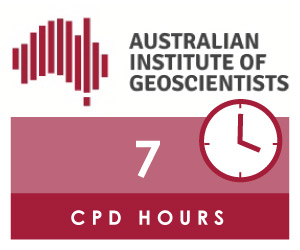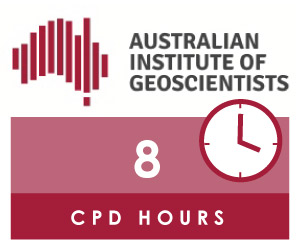Geology from Geophysics – a one day symposium presented by ASEG in conjunction with ASEG-PESA 2015
With exploration increasingly taking place ion areas with poor outcrop or under significant cover, the need for explorationists to obtain geological information from geophysical data has never been greater.
Intended for geoscientists working in the minerals industry, this 1 day symposium brings together industry and academic geoscientists who are world-leaders in the fields of practical geophysical data interpretation and integration of geoscientific datasets for mineral exploration applications.
 Regional Metallogenic to Local Controls on Circum-Pacific Gold and Copper Deposits is a short course to be presented prior to PACRIM 2015 (Workshop W2). This one-day workshop will be held at the Conrad Hotel in Hong Kong, China on the 17th of March, 2015. The course will be of particular interest to geoscientists seeking to broaden their understanding of ore-forming processes and who wish to explore for gold and copper deposits in the circum-Pacific region.
Regional Metallogenic to Local Controls on Circum-Pacific Gold and Copper Deposits is a short course to be presented prior to PACRIM 2015 (Workshop W2). This one-day workshop will be held at the Conrad Hotel in Hong Kong, China on the 17th of March, 2015. The course will be of particular interest to geoscientists seeking to broaden their understanding of ore-forming processes and who wish to explore for gold and copper deposits in the circum-Pacific region.
The workshop will consist of two parts. The first, presented by Steve Garwin, is titled Tectonic and Structural Controls to Gold and Copper Mineralization in the Circum-Pacific Region. This presentation will consist of three main topics:
The second part of the course, presented by Craig Hart, is titled Intrusion-related Gold Metallogeny. This presentation will consist of three main topics:
Presented by:
Steve Garwin
Independent Consultant; Adjunct Research Fellow, CET, University of Western Australia, Australia
Steve has 25 years of experience as an exploration geologist in SE Asia, China, Papua New Guinea, Solomon Islands, Australia, the western USA, British Columbia, Mexico, Peru, Ecuador and Chile. He worked with Newmont Mining for ten years, including two years as Chief Geologist in Nevada. Steve is one of the leading authorities on epithermal, porphyry and Carlin-style mineralization in the circum-Pacific region, particularly SE Asia. He has been an adjunct research fellow at the Centre for Exploration Targeting at the University of Western Australia since 2001.
Craig Hart
Director, MDRU-Mineral Deposit Research Unit, University of British Columbia, Canada
Craig is the Director of MDRU, the Mineral Deposit, Research Unit at the University of British Columbia. His experience includes regional geological mapping, mineral deposit and regional, metallogenic studies, plutonic systems, geochronology, and exploration, targeting orogenic belts around the word. He is a major contributor, to the development of intrusion-related gold models, is dedicated to, graduate student research and training, and a recipient of the SEG Distinguished Lecturer (2011).
The early bird registration for the PACRIM 2015 Congress closes on the 31st of January. The three day program will present over 85 technical abstracts plus an additional 7 keynote presentations from renowned international speakers.
Click here for the workshop brochure.
Register for workshop W2 here.
AIG is a supporter of PACRIM 2015. AIG members are eligible for supporter’s rates.
In the first quarter of 2014 the AIG Australian Geoscientist Employment survey recorded the highest levels of unemployment and underemployment since the surveys commenced in 2008. The September quarter survey showed the first signs of improvement in employment conditions after a protracted downturn. This survey is intended to measure whether this improvement continued through to the end of 2014, setting the scene for the New Year.
With your support, The AIG Australian Geoscientist Employment Survey is now regarded as a trusted indicator of geoscientist employment specifically, and an indicator of the health of Australia’s exploration and mining sector more generally. We need your support, for a few minutes every every quarter to maintain the value of this series of surveys.
The surveys provide a snapshot of employment opportunities for Australian geoscientists based on “hard data” from a representative sample that is used in representations to government, and for use in a range of other areas by both AIG and industry representative bodies with which AIG shares the survey results.
Click here to complete the survey. The survey collects no identifiable, personal information and takes less than two or three minutes to complete. Your time spent completing the survey really helps to make a difference to the standing and knowledge of our profession. The survey will remain open unto 31 January 2015.
The five day exploration skills course for graduate geoscientists planned for Kalgoorlie, Western Australia, 19-23 January 2015, organised by the AusIMM Geoscience Society and Digirock and supported by AIG, has been postponed until later in 2015.
The course brochure which provides course content and structure information is available here. Watch the web site for information regarding rescheduling of this valuable course.
From January 1, 2015, all students undertaking any form of training with a nationally recognised training provider in Australia will be required to have a Unique Student Identifier (USI). The USI program is administered by the Australian Government Department of Industry.
A USI is an account (or reference number) made up of numbers and letters. The USI will allow your students online access to their training records and results (transcript) through their online USI account.
A USI is required for both new and continuing students undertaking nationally recognised Vocational Education and Training (VET) courses to receive their statement of attainment or qualification.
A USI may be obtained online and at no cost to students. This USI will stay with your students for life and be recorded with any nationally recognised VET course that is undertaken from the 1 January 2015.
Students can access their USI accounts online from computers, tablets or their smart phones anytime.
Find out more from the USI website
The 68th UN General Assembly has declared 2015 the International Year of Soils (IYS).
The Food and Agriculture Organization of the United Nations has been nominated to implement the IYS 2015, within the framework of the Global Soil Partnership and in collaboration with Governments and the secretariat of the United Nations Convention to Combat Desertification.
The IYS 2015 aims to increase awareness and understanding of the importance of soil for food security and essential ecosystem functions.
The specific objectives of the IYS 2015 are to:
Find out more from the IYS web site
 “Geophysical signatures of mineral systems; more than bumps” is a workshop being held as part of the ASEG-PESA 24th International Geophysical Conference and Exhibition in Perth, 15-18 February 2015. The convention organisers have decided to make workshop registration available to attendees who have not registered for the conference itself.
“Geophysical signatures of mineral systems; more than bumps” is a workshop being held as part of the ASEG-PESA 24th International Geophysical Conference and Exhibition in Perth, 15-18 February 2015. The convention organisers have decided to make workshop registration available to attendees who have not registered for the conference itself.
Date: Thursday 19 Feb
Cost: Standard $180, students $80 (Students must provide proof of student status)
Location: Meeting Room 10, Perth Convention and Exhibition Centre
Conveners: Ken Witherly: Condor Consulting & John Hart:RioTinto Exploration
Workshop Details
It is generally accepted that the shallow, easy to define ore bodies were recognized first and developed. In the past 20 years, the discovery performance across virtually all mineral sectors has fallen, resulting in growing concern that if unchecked, there could be shortfalls in a number of commodities within the next 20 years.
The collective sense is that the geological column hosts more deposits than have been found to date but these are expected to be at greater depths than have typically been explored before. To be able to operate in this environment, new approaches to the identification of deposits is required and the concept of a mineral systems approach, first suggested 20 years ago, has emerged as a powerful means to build strategies and capabilities going forward. In terms of geophysical exploration, the major change that will be required is a shift from a focus almost entirely on direct targeting of deposits with geophysical surveys to a staged process where geophysical approaches are used initially to help define the pathways in the Earth which carried the mineralizing solutions which formed the target deposit.
These pathways would provide a much larger target to explore for and if detected and mapped, should allow explorers to follow the pathway to the location of potential deposits. This task is different from most geophysical studies undertaken, where the focus has been typically on improving the direct targeting capabilities and not the larger scale mapping problem that a mineral systems approach will require. In the current assessment, a review is undertaken of what is seen as the current state-of-play for a number of major deposit styles and how geophysical data is being used at present to explore for these. The assessment overall is encouraging but major challenges remain outside of the technical issues of defining a mineral systems strategy that relate primarily to human resources and the commercial environment.
This forum will examine the current state of understanding of geophysical signatures of mineral systems; current examples, on-going research and areas which require further assessment. A major tenant that is already apparent is that the successful development of undercover exploration strategies will require a degree of integration of geophysical outcomes with other geoscience data not typically achieved historically.
Visit the AIG Events Calendar for additional information.
 BIG Data, Inspiring Information and Strategic Knowledge, is being presented in Perth WA, 23 March 2015 by AIG and Geoscientists Symposia.
BIG Data, Inspiring Information and Strategic Knowledge, is being presented in Perth WA, 23 March 2015 by AIG and Geoscientists Symposia.
This international symposium will examine data management and effective data conversion to knowledge that delivers growth in the exploration and mining sectors.
The latest symposium circular is available here and provides full programme and registration details.
Best wishes to all AIG members for the New Year. Lets work to help make 2015 a productive and prosperous one for Australian geoscience.
There are a few exciting developments in preparation for 2015 including:
Have you checked out AIG’s weekly compilation of popular geoscience articles yet? AIGeoscope is updated every Monday and available here.
We will be continuing the monitor the employment situation for Australian geoscientists throughout the year and appreciate the ongoing support of both members and non-members by their continued contributions to what we feel is an important survey. You Institute will also be continuing to represent members on important professional issues and committees, including JORC and VALMIN.
Is there anything you would like to see AIG do or introduce in 2015? Have your say here or via the AIG Linkedin Group or Facebook page. If there’s anything on your mind about Australian geoscience or your career have your say. We’re listening.
AIG will continue to be a dynamic and responsive professional institute, representing the interests of members throughout Australia and internationally.